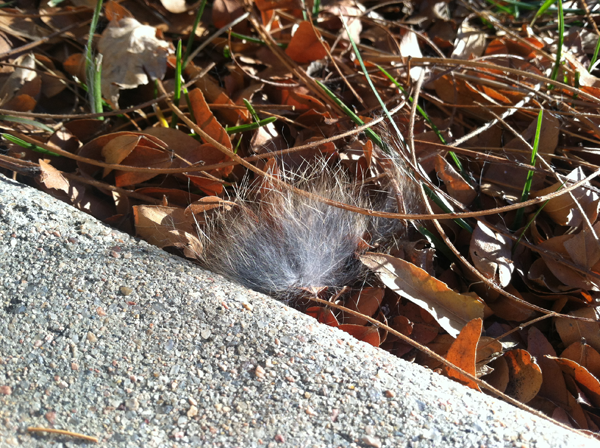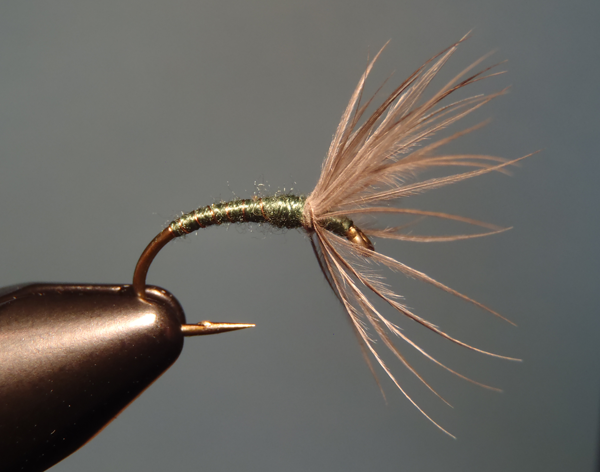Fly tiers have it pretty easy these days. Run out of red floss during a marathon tying session of Royal Coachmans? Head down to your local fly shop and pick some up. Need fluorescent pink guinea fowl for a killer new Spey fly? Order in online and it will be at your door in a few days.
But imagine what it must have been like for early tenkara anglers. Not only were there no fly shops (or e-commerce) back then, but living in remote mountain villages, they were pretty much cut off from the rest of the world. They had to tie flies with whatever they had available to them locally.
This forced them to be pretty creative when designing flies. And it got me thinking…
If I lost all access to fly tying materials, what would I do? Could I rise to the challenge and continue to tie with only materials I could find in my day to day life?
As luck would have it, I was contemplating this on a cigarette break outside my office. I happened to look down and see some small clumps of rabbit fur on the ground. Then, I glanced over to my right and saw a feather in the grass that looked like it could actually be wrapped like hackle. Not ideal, but about the right size.

So, I snatched them up and figured I could probably make a pretty convincing soft hackle with it. This was the result:

Hook: TMC 900BL #10
Body: rabbit fur I found in a parking lot
Ribbing: mylar strip cut from a potato chip bag
Hackle: Unknown feather I found in a parking lot (possibly magpie)
Ok, I cheated a little bit. I did use a vise and modern fly tying tools. But for not using any store bought materials, I think it came out pretty good! So, I decided to try a couple more…

Hook: TMC 900BL #10
Body: Light green strip cut from a Mylar baloon
Thorax: Rabbit fur I found in a parking lot
Hackle: Unknown feather I found in a parking lot (possibly magpie)

Hook: TMC 2457 #12
Body: Green sewing thread
Ribbing: copper wire from old headphone cables
Hackle: Unknown feather I found in a parking lot (possibly magpie)
Now this convinced me that it was possible to tie with found materials. If you think about it, it’s probably much easier today to find good materials then it was hundreds of years ago in some remote village simply because there is just more “stuff”.
In fact, a Tenkara angler from 1700 would probably think of a modern household as a materials paradise, never mind what we have available to us through the Internet.
The more I thought about it, I realized that fly tying materials are actually all around us–in our houses, the park, the trails, even the parking lot. We just don’t pay enough attention to it since our ideas about where to get materials have been so conditioned to fly shops.

Where to find fly tying materials
This is not a comprehensive list by any means but just a quick brainstorm of where to find materials if you want to try tying some flies with things you can find in your everyday life.
Dubbing/body material
- Dog fur
- Shed fur on hiking trails
- Road kill fur
- Dryer lint
- Knitting yarn
- Knitting yarn
Wings
The materials below can be cut into a wing shape and colored with an indelible marker such as a Sharpie for surprisingly realistic looking caddis and mayfly wings. In some cases, you might want to coat them with something like Seal All to add durability.
- Dryer sheets
- Ziplock bags
- Tyvek home wrap or USPS priority envelopes
- Old nylon stockings
- Scotch tape (folded)
Ribbing material
- Copper wire from old headphone cables, extension cords, etc.
- Stretched rubber bands
- Thick sewing thread
- Slice Mylar balloons or potato chip bags into thin strips
- Monofilament or fluorocarbon fishing line
Tails/antennae
- Paint brush bristles
- Used tippet material
- Individual fibers from found feathers
Hackle
This one is a little trickier because you need a feather with the right characteristics (and size). Unless you want to spend your whole life looking down for the off chance of finding one and run the risk of slamming your head into a telephone pole, it’s probably better to focus your efforts on specific places:
- Pet store
- Zoo
- Petting zoo
- Below birds nests
- Farm
- Friend’s pet bird cage
- Shoreline of a lake or pond
If I thought about it more, I could probably go on and on but I think you get the idea. Tying with found materials is a unique challenge and one that I will continue to explore.
I can’t help but wonder if the ubiquitousness of fly tying specific materials has taken some of the romance out of our flies. Everyone has access to the same, consistently dyed and prepared materials, so our flies lose some uniqueness. They become uniform.
In early Japan, unique styles of flies evolved based not only on local conditions, but also on what tenkara fishermen had available to them in their individual villages. Perhaps it’s an overly sentimental notion, but I think it would be interesting if we all had to rely on locally found materials to tie. Wouldn’t it add something magical to our sport if you could look at a fly and tell who tied it or where it came from just based on design?









Great post Jason. This is a subject that I am into as well, you may remember my “PieceOfStringIPickedUpOffTheFloor Kebari” after all..
Brian
Yep, I remember it Brian. That was a great post and a good example of tying with found materials for sure. 🙂
A tan-shag-carpet killer bug, what else would you do with a shag carpet? I often find deer hair caught in the barb-wire fence between my land and my neighbor’s pasture.
great post Jason, I often think about this stuff too, as a matter of fact that is what inspired me to use the snake skin I sent you as a tying material. I think besides being very economical, using locally sourced tying materials gives a greater sense of acomplishment, and I also think that, that is how many Japanese anglers came up with their “one fly” in the past, I think it was less of a tactical choice and more of a choice of what was available to them.
I quite often use my dogs, yarn, rabbits, skunks as dubbing; I have access to a nearly limitless supply of feathers with my chickens and a friends aviary; I have also made hackle from yarns, synthetics packing materials, and my own hair in a dubbing loop. That’s all I can think of right now, I think my cat needs a shave, I just realized his 2 toned fur!
The flies look great. You’re definitely going to fool some fish with ’em too. I have in the past used a candy wrapper for scud back but that is about as far as I’ve taken it. Good post, I’m inspired!
JD
Thanks JD! The more I think about this idea the more potential I see.
“I resemble you remarks”! In fact, until the late 70’s, this was the way of the fly fish angler.
Even as late as the 60’s and early 70’s, fly shops were pretty rudimentary and very traditional.
There is now also a plethora of modern materials that have revolutionised fishing.
Al we had for thread was sewing or ultra expensive pearsalls. Ribbing was wrapper, telephone or tansformer wire, or copper scrubber. Genetic capes make it much easier and cheaper now. Furs were often road kills or an afternoon on a farm or an outing with the rifle.. Dubbing was hand mixed. Wools were sourced for raw materiall. I still have the recipes for various dyes from natural sources.
And yes, we did have electricity, I’m not that old.
Maybe I’m too nostalgic but that sounds like more fun than entering a credit card number to get the materials you want. Deeper connection to the sport too.
I have a chow mix and he has a very flowing tail or rust colored fur. Before I even began tying flys I saw the potential in his fur. In long cuts it behaves like marabou and I have created the “wooly gunther” in his name sake. It was my attempt to recreate a fly I lost to a try that was black with a orange color of marabou on the end. To say the least it catches fish!
Nicely done! I’m always searching for more materials. As a biologist I keep a kit in my work truck and car that includes zip lock bag, razor blade, and scissors for those carcasses I cant pass up.
Great ideas for taking some of the expense out of tying fly’s. Any suggestions for materials to use for “rubber” legs for poppers and other fly’s?
Rubber bands! Color them with Sharpie Markers.
Look inside of a stretchy Bungie Cord for a supply of legs that will last for years for most tiers
nice post. I’m writing from mongolia. We dont have materials like in ebay website. for dubbing i vacuum clean new carpet, for scud back i use wife’s brassiere shoulder loop, or condom and after make it color by markers. sorry my bad english
I did one out of green pine needle as tail,
yellow cross stitch floss as body,
pine needle for rib,
pine straw for throat, and
used a leaf for a wing.
It looks interesting
I have a couple chickens in the backyard and do collect the moulted feathers for soft hackles. They work good, especially the feathers from the golden-laced wyandotte.
However, one needs to be surreptitious if directly plucking or cutting materials from a pet. Many would disapprove… 😉
http://www.washingtonflyfishing.com/gallery/showphoto.php?photo=49901
on somewhat of the same note, check out Jay Fullum’s, “Fly Tying With Common Household Materials”. lots of good ideas to take to the vice.
Jason, this is another great article. Tenkara=Simplicity. Your article couldn’t have come at a better time. Being new to Tenkara and tying my own flies, your ideas will be very helpful. I live on a small organic farm where I raise dairy goats, Guinea fowl, rabbits, chickens and turkeys. I laugh at myself as I walk toward the barn looking at the ground and under nesting boxes for materials that are too many to count. When a bright red rooster walks nearby I feel the urge to snatch a few tail feathers and run to the vice. It really has become quite funny but resourceful at the same time. Thanks again for a nice article.
Thanks Jason, so helpful!!
I didn’t see it mentioned but down pillows and comforters are full of feathers, if it’s the right size/strength for the fly.
Thanks!